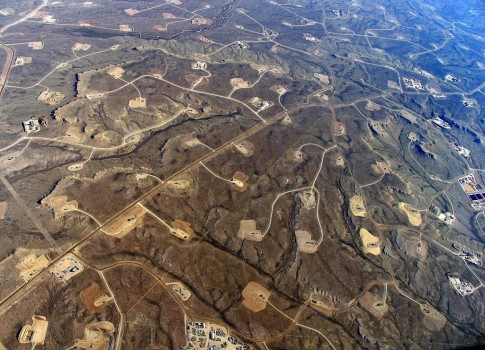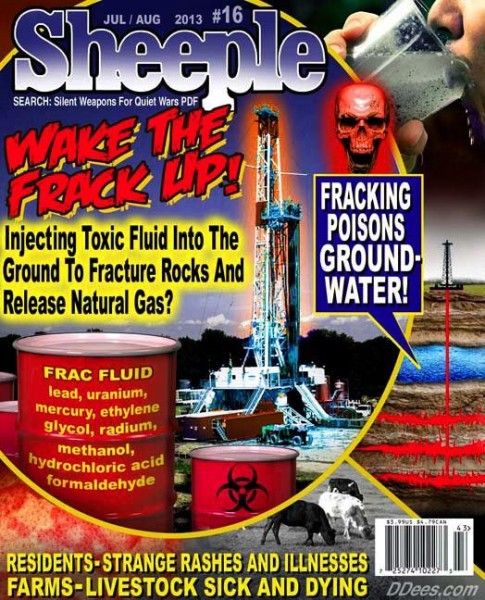
In areas where shale-drilling/hydraulic fracturing is heavy, a dense web of roads, pipelines and well pads turn continuous forests and grasslands into fragmented islands. Credit: Simon Fraser University.
– Here’s the New Study the Fracking Industry Doesn’t Want You to See:
Though fracking industry proponents scoff at any intimation their so-called vital industry poses even scant risks to the public, a new study published in Toxicology and Applied Pharmacology just proved those critics right — fracking wastewater causes cancer.
Using human bronchial epithelial cells, which are commonly used to measure the carcinogenesis of toxicants, researchers confirmed fracking flowback water from the Marcellus Shale caused the formation of malignancies.
After conducting further tests on live mammalian subjects, researchers found five of six mice “injected with cells transformed from well water treatments developed tumors as early as 3 months after injection,” including a tumor in one mouse that grew to over 1 cm in size in just five months. A control group did not develop any tumors for the six months of the study period.
According to the study, performed by scientists from the Department of Environmental Medicine, as well as Biochemistry and Molecular Pharmaceutical at New York University, the Robert Wood Johnson Medical School at Rutgers, and esteemed partners from universities in China — results indicate fracking flowback water causes cancer.
Implications of the report’s findings would be difficult to overstate considering how fracking wastewater is generated, stored, and treated, and how often spills, leaks — and even the wastewater injection process, itself — can lead to contamination of the potable supply. A concise but thorough explanation of the fracking process can be found in the introduction to the report, “Malignant human cell transformation of Marcellus Shale gas drilling flow back water,” which states:
“Natural gas is believed to possibly be a bridge to transitioning from coal dependence. Currently natural gas fuels nearly 40% of the U.S. electricity generation, and the Marcellus Shale formation in the Appalachian Basin is on the forefront of gas-shale drilling for natural gas production in the United States. Mining natural gas is not new, but the volume has soared in recent years because the new technique of high-volume horizontal hydraulic fracturing (HVHHF). The concern surrounding the environmental, public health, and social impacts of this method has increased accordingly. HVHHF is an advanced technology that injects water, sand, and other ingredients at very high pressure vertically into a well about 6000 to 10,000 feet deep. The high pressure creates fractures in the rock that extend out as far as 1000 ft away from the well. The pressure is reduced after the fractures are created, which allows water from the well to return to the surface, also known as flow back water [or flowback]. The flow back water contains complex proprietary chemical mixtures, but also naturally occurring toxins such as metals, volatile organics, and radioactive compounds that are destabilized during gas extraction. On average, 5.5 million gallons of water is used … to hydraulically fracture each shale gas well, and 30% to 70% of the volume returns as flow back water.”
Options for dealing with this flowback are somewhat limited. The report continues:
“Currently discharge options of flow back water are: inject underground through an onsite or offsite disposal well; discharge to a nearby surface water body; transport to a municipal wastewater treatment plant or publicly owned treatment works;” or other treatment, transport, and/or reuse options.
But concerns about the contents and impacts of wastewater are the reason researchers studied its effects:
“Metal pollution is a serious problem as they are taken up readily in the digestive tract and exhibit harmful effects on many tissues. Barium and strontium are abundant in the Marcellus Shale formation, and are easily dissolved and transported in wastewater after gas drilling activity, which could potentially pose a threat to drinking water.”
In fact, in 2014, environmental consulting firm Downstream Strategies diligently attempted to track fracking water from Marcellus Shale drilling — both water withdrawn from sources for use in the process, as well as wastewater — but found it to be a nearly impossible task.
“We just couldn’t do it,” said staff scientist Meghan Betcher, according to Yale’s e360.
Regulatory requirements that would otherwise divulge where these massive quantities of water end up are simply not in place. According to the Downstream Strategies study, “gas companies use up to 4.3 million gallons of clean water to frack a single well,” and “more than half of the wastewater is treated and discharged into surface waters such as rivers and streams.”
Additionally, in 2013, Duke University geochemists published a study that found“dangerous levels of radioactivity and salinity at a fracking disposal site near Blacklick Creek, which feeds into water sources for Pittsburgh and other western Pennsylvania cities.” Even more disturbingly, after studying soil samples for two years, between 2010 and 2012, “After wastewater was treated at the plant to remove dangerous chemicals, radiation was detected far above regulated levels.”
“Each day, oil and gas producers generate 2 billion gallons of wastewater,” Duke Professor Rob Jackson stated, as Business Insider reported. Though the disposal site near Blacklick Creek has since ostensibly agreed to stop storing or treating Marcellus Shale fracking waste, the industry is far from clean — or transparent.
“They produce more wastewater than hydrocarbons,” said Jackson of the natural gas industry. “That’s the broader implication of [the Duke] study. We have to do something with this wastewater.”
Considering the Marcellus Shale study and the now-proven cancer link, fracking wastewater just became enormously important to millions of people living near thousands of wells in the United States, as well as other countries.
As the Downstream Strategies researchers found, due to lack of regulatory reporting requirements for the fracking industry — aided greatly by its exemption from the Safe Drinking Water Act by law in 2005 — “the fate of 62 percent of fracking waste is unknown.”
Researchers for the carcinogenicity study of flowback claim progress with their findings, identifying barium and strontium as traceable fracking contaminates, which they say should now be designated for further study. As the study concludes:
“Research to determine whether fracking-associated pollutants can migrate to private or public drinking wells, to identify early warning indicators of exposure and effect, and to identify suitable remediation approaches are urgently needed.”
Related information:
– New York State BANNING Fracking Due To Earthquake & Environmental Threat
– Californians Outraged As Oil Producers & Frackers Excluded From Emergency Water Restrictions
– Fracking Is Draining Water From US Areas Suffering Major Shortages
– Fracking’s Terrifying Water Usage Trends Spell Disaster
– USGS Confirms Oklahoma Quakes Are Due To Fracking
– Frackquake: 4.8 Magnitude Earthquake Felt Throughout Kansas
– WTF: Fracking firms should be allowed to cause bigger earth tremors, academics claim
– ‘US fracking extremely dangerous, poses cancer threat’
– Farmers Fear Fracking Could Spell Financial Ruin
– Largest Kansas Earthquake In 140+ Years – 4.4M Strikes FRACKING Operation (Video)
– Just 4 Fracking Wastewater Sites Cause 20% Of All Central US Earthquakes
– Will Fracking Cause Our Next Nuclear Disaster?
– Allow Fracking In NATIONAL PARKS, Says UK Environment Agency Chief
– WTF: North Carolina GOP Pushes Unprecedented Bill To Jail Anyone Who Discloses Fracking Chemicals
– Exxon CEO Fights Fracking … When It Comes Near His Texas Ranch
– Fracking Is Draining Water From US Areas Suffering Major Shortages
– Fracking’s Terrifying Water Usage Trends Spell Disaster
– Prof. Chris Busby For RT: Wrecking The Earth: Fracking Has GRAVE RADIATION Risks Few Talk About
– Texas: The Worst Drought In Two Generations Is Choking Water Supply, Which Is Why Residents Now Turn Against Fracking
– ‘The Real Threat: Acid Jobs’
– Fracking Our Food Supply – Livestock Falling Ill In Fracking Regions
– David Letterman On Fracking:‘We’re Screwed’ (Video)
– Human-Made Earthquakes Reported In Central U.S (Reuters)
– US Government Confirms Link Between Earthquakes And Fracking
– European Gas Giant Backs French Fear Of Fracking
– Texas Forces Firms To Open Up On ‘Fracking’
– Fracking Hell: Toxic And Radioactive Waste – The Untold Story
– The Oil and Gas Industry’s 800-Pound Gorilla: RADIATION!
– ‘Fracking’ Result (= Contamination) For UK Shale Gas Will Be Kept Secret Until 2015
– US: Natural Gas Wells’ Contaminated Water Hits Rivers



Again, those who we pay to protect us, do the opposite.
http://comingcleaninc.org/wind-blows